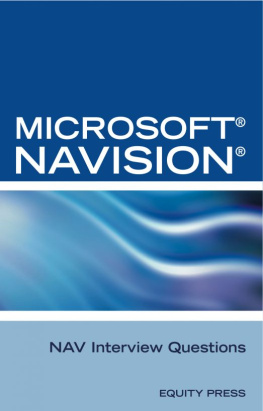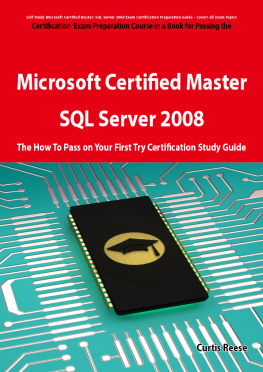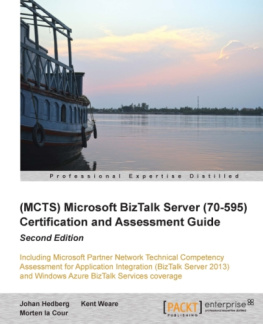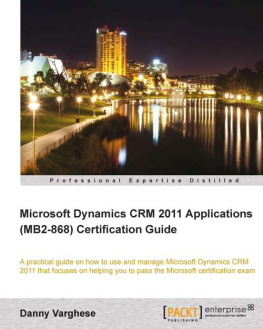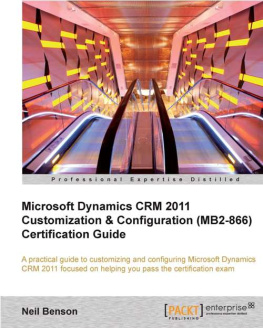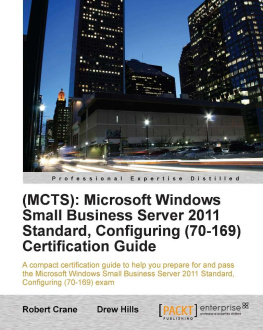MICROSOFTDYNAMICS
NAVISION
Frequently AskedQuestions:
MS Navision FAQ
Compiled by Terry Sanchez-Clark
MICROSOFT DYNAMICS NAVISION Frequently Asked Questions: MSNavision FAQ
ISBN978-1-60332-224-9
SmashwordsEdition
Edited by: FarrahStewart
Copyright 2008 Equity Pressand ITCOOKBOOK all rights reserved. No part of this publication maybe reproduced, stored in a retrieval system, or transmitted in anyform or by any means (electronic, mechanical, photocopying,recording or otherwise) without either the prior written permissionof the publisher or a license permitting restricted copying in theUnited States or abroad.
The scanning, uploading anddistribution of this book via the internet or via any other meanswithout the permission of the publisher is illegal and punishableby law. Please purchase only authorized electronic editions, and donot participate in or encourage piracy of copyrightedmaterials.
The programs in this bookhave been included for
instructional value only.They have been tested with
care but are not guaranteedfor any particular purpose.
The publisher does not offerany warranties or
representations not does itaccept any liabilities with
respect to theprograms.
Trademarks: All trademarksare the property of their respective owners. Equity Press andITCOOKBOOK is not associated with any product or vendor mentionedin this book.
Please visit our websiteat www.itcookbook.com
TABLE OF CONTENTS
arily
Navision has gone through several name changes since1995 . Currently, itis marketed by Microsoft as Microsoft Dynamics NAV. Its previousnames include Navision Financials, Navision Attain, andMicrosoft Solutions Navision Edition. All these refer essentiallyto the same product.
Microsoft Dynamics NAV is an enterprise resource planningsoftware intended to assist small and medium-sized enterprises with finance,manufacturing, customer relationship management, supply chains,analytics and electronic commerce. Its cost-effective solution can easily be tailored for anycompany. It can support customization and add-in software to meetindustry or other specific needs. Moreover, it can adapt as agrowing business needs more power and functionality.
Microsoft Dynamics NAVaddresses the following business needs:
Financial Management : Record and store financial records in a centralgeneral ledger that includes charts of accounts, balances, VATreporting, and more. It allows you to define your preferredcurrency, create accounting periods based on your fiscal andbusiness cycle, manage bank accounts and cash, and automateroutines such as check-writing and bank statementreconciliation.
Manufacturing: Manufacturers can respond quickly to customerdemands and improve manufacturing performance by automating andimproving processes such as production-order management, supply andcapacity planning, visibility into shop floor operations, andgraphics-based production schedules.
BusinessIntelligence: Turn raw data intounderstanding of how a business is operating. It allows you tochoose from basic to advanced analytics functionality, providedecision makers with a 360-degree view of performance, and set upgraphical reports and displays using an interface similar toMicrosoft Outlook 2003.
Sales and Marketing: Put customer information at the fingertips ofmanagers and employees to help your people build better customerrelations. It manages contact information, organize salescampaigns, identify sales opportunities, automate sales tasks, andset up automatic reminders.
Distribution: Microsoft Dynamics NAV gives businesses a flexiblesolution for solving distribution challenges. It can be used totrack and manage inventory, including in multiple locations; getup-to-date information about in-stock quantities; implement betterwarehouse management, including tailored pick orders and stockreplenishment by pre-set thresholds; and get real-time dataregarding inventory and shipments
Integration with yoursystems: Microsoft Dynamics NAV is designedto work smoothly with other Microsoft products such as MicrosoftOffice Suite, Microsoft SQL Server 2003, and Microsoft Windows 2000and XP. Its commerce portal capabilities also allow a company tocreate a Web site to work easier with customers and partners. Itcan also be integrated with a wide range of other softwareproducts, so that even if a small business has already substantialIT infrastructure, it can be used with Microsoft Dynamics NAV sothat a business makes the most of its IT investment.
We are developing acustomization to Navision and my research into Navisionsclient/server options has produced mixed results. I know withAxapta that one can have a server that has all of the applicationobjects, and the clients can just connect to the server and grabany of these objects to execute as needed.
Is there something similarto this in Navision? Or will our customers need to import ourobjects on every client machine?
A: No, you do not need toexport the objects to your clients machine. All you have to do isto install one server and all your clients would have to connect tothat server.
I want to run Navision uponsigning in into a remote server with the remote desktopconnection.
What is the executablecommand line I can use for this?
A: You can find the command lineparameters by looking at the Installation Section of theConfiguration Manual. In there are the various parameters. It is inthe DOC folder of NAV product CDs.
I have a comma delimitedlist (and excel file) of SIC codes and I want to import them tobecome Industry Groups.
Is there something that Ican do get them in one batch rather than entering each onemanually?
A: You will need to access ObjectDesigner and then design a simple Dataport to import your codesinto the Industry Group table. Have a look at an existing Dataport(maybe 5901 - Import IRIS to Fault Codes) to see how they hangtogether.
I find Navision to be slowin opening any process even for just one user. And I have about 30users on the system. It takes two to three minutes to move fromscreen to screen. I have deleted before the zup file and it worked fine for twodays. Now, when I delete the zup file, it does not make it better. What elsecan do? Could anyone help me?
A: There are many things that youcan look at, such as the following to mention a few:
1) How are your usersconnecting to the system, i.e., 10/100/1000 or citrix orrdc?
2) The SQL or nativedatabase and its size
3) The server specs, i.e.,the RAM, number and type of disks and the type of raid yourusing.
4) Customizations with badcode
5) The version you are usingand whether you have all the updates
6) SQL tweaking if that iswhat you use.
If you are using a Nativedatabase, you can check the Object Cache / DBMS Cache for thedatabase on the server.
We utilize the dataport inNavision to import data on occasion. Recently, we are experiencingproblems with some of the dataports. Sometimes they work fine. Atother times they crash Navision on the client and a dialogue boxasks if I would like to send an error report. The DP starts andruns in part before crashing. It ran several times on the sameunchanged file but crashed at a different percent each time. Itdoes not seem to be the file because after a crash, it still workson the following attempt. By the way, it happens in many machinesand even happens on our VAR on some occasion.
How do I fixthis?
A: If you are experiencing it injust one particular machine, first delete the zup and then give it a try. Second,go to Tools Options and then increase the cache. Third, if all else fails,reinstall the client. But before reinstalling the client, deletethe zup andincrease the cache first and observe if it happensagain.
I am taking over a projectthat customized Navision. The menu suite that we use for ourcustomization is at the Partner (80) level. But since this numberis not in the range where we have our unique IDs, I assume that itis possible that a customer would already have a menu suite at thePartner level. Is this accurate? And if so, I would think theywould have to merge our code for the menu suite with their existingcode. Is this also accurate? Could anyone elucidate onthis?
Next page
